Exercises for Seniors
Exercises for seniors
will aid in maintaining a good posture. Posture is especially important
in older people as muscles on the front of the chest and hips often
become tight and pull us forward. That is why some develop a rounded
back posture and tend to walk bent forward. It is
necessary in order to maintain a good posture and functioning range of
motion to find the balance that should exist between extensors and
flexors all over the body.
A we age connective tissues become less elastic, so while those under
35 can manage with stretching two or three times a week,
those older would benefit more from stretching daily.
What
are
Some Exercises
for Seniors?
What
are the Benefits to Seniors?
How
Does
Aging Affect How We Should Stretch?
How Does
Aging Affect
Fascia?
Flexibility
for Function
Guidelines
for
Stretching for Seniors
Yoga
for Seniors
Stretches
for Seniors
Barriers to Exercising
Other Relevant Sites
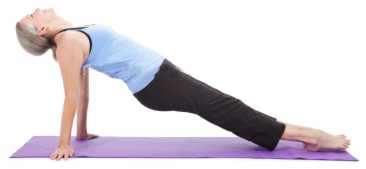
What are Some Exercises for Seniors?
Exercises
for seniors should include the following:
- strength training to maintain muscle and bone mass,
- balance or proprioceptive training to prevent falls,
- aerobic or endurance exercises to maintain a healthy cardiovascular system, and
- exercises for seniors should also include a comprehensive stretching program to maintain joint and muscle flexibility.
Since this is a website to specifically cover stretching, that is what we will focus on here. I will provide links to other relevant sites at the bottom of this page.
What are the Benefits of exercises for Seniors?
The key to feeling better and living better is staying active.
Exercises for seniors can
- prevent cardiovascular disease,
- delay the onset of diabetes,
- diminish the symptoms of depression and improve mental health, and
- relieve the pain from arthritis.
- diminishes the risk of falling or if a fall occurs, speeds up one's ability to recover from a fall
Even if you've never undertaken an exercise program, it is not too late
to start reaping the benefits. By remaining active, exercises for
seniors will help you continue to do all the things you like to do and
remain independent as you get older.
Exercises for seniors don't have to be undertaken in a rigid class
format. Activities you love such as gardening, going for a brisk walk,
or raking leaves are all forms of exercise. The benefits you get from
activity is cumulative, so just several brief bouts of exercises
through the day can be as good as one long exercise session. Either way
it's important to fit it into your lifestyle in an enjoyable way in
order to stick with it.
How Does Aging Affect How We Should Stretch?
There is plenty of research to compare different stretching techniques
to advise us what works and what doesn't. Stretching provides benefits
that include improved flexibility, improved athletic performance,
decreased energy expenditure with movement, and injury prevention.
It is also believed that stretching helps to promote healing
and
possibly reduce the delayed onset of muscle soreness. (1,2)
Research has been done into the effect of different forces
used,
different positions, variable frequency and duration, but in the
majority of studies the subjects used are between the age of 18 and
40. The results of this research may therefore not be
applicable
to those that are older, particularly the elderly, due to age related
changes that occur in muscle and connective tissue physiology. These
age related physiologic changes that will impact stretching are as
follows:
- increased fibrous connective tissue in joints resulting in stiffness
- reduced elasticity and strength of soft tissue matrices
- decreased capacity for healing
- less capillary blood supply
- muscle atrophy
- decreased numbers of mesenchymal stem cells
Musculoskeletal flexibility is in large part due to connective tissue
compliance and elasticity. Muscles of older individuals are more
susceptible to injury during eccentric contractions (the muscle is
lengthened during its contraction) and are slower to recover
from
trauma. (3)The diminished capacity for healing and higher risk of
injury
is why it is best to use static stretching techniques as
opposed
to PNF or ballistic techniques in elderly people. A cyclic stretching
technique is probably more beneficial for older
individuals because of increasing muscle stiffness and collagen
deposition that comes with age.
A study done in 2001 amongst 60 healthy people (mean age
84.7,
SD=5.6) with tight hamstrings compared stretching of the
hamstrings held for 15, 30 and 60 seconds over a 6 week period.(4)
The results of this study indicated that a sixty second stretch was
more effective than a thirty second stretch within this group of
elderly individuals. Previous studies with a younger population
suggested that a sixty second stretch was just as effective as a thirty
second stretch. In this study a sixty second stretch repeated four
times, once a day, five times per week for 6 weeks improved hamstring
flexibility in people over 70 better than those that stretched 15, or
30 seconds. In this group, however, improvements in range were also
seen in those stretching 15 seconds and 30 seconds. In other words a
short stretch is better than no stretch, but 60 seconds is optimal.
This study also showed that stretching must be continued if
the
benefits of stretching are to be maintained over time.
How Does Aging Affect Fascia?
Connective tissues like fascia change as we get older. Collagen content in the fascia increases as does cross bridging between the collagen molecules. Elastin content decreases and becomes fragmented. A tendency to become dehydrated also reduces elasticity in fascia. However, research shows that the more you stretch, the more your body produces the substances needed to maintain flexibility.
Flexibility for Function
Reductions in joint mobility normally come with age and research has shown that with this loss of flexibility comes poorer scoring in measures of performance in activities of daily living. Likewise studies have shown that when groups of individuals improve their flexibility, their quality of life scores also improve. Research shows that there are declines in joint range of motion with age from 70 to 92 years of age, with increasing decline into the 90's. (5,6) Maintaining this mobility is important to maintaining function.
Guidelines for Stretching for Seniors
Stretching should not cause pain or serious fatigue. You may feel some
discomfort that goes away when tension is released, but there should be
no pain. Here are some basic guidelines for exercises for seniors:
- Start slowly. Chances are it's taken years for you to get this stiff. It's not going to be fixed in a day.
- Drink plenty of fluids unless your doctor has advised you against this.
- Don't hold your breath during stretching. Relaxed breathing actually helps your muscles relax.
- Always be aware of the position of your spine. Any extremes in curvature can make you vulnerable to injury.
- Warm your muscles briefly prior to stretching by taking a short walk or using some light dumbbells.
Return to top
Stretching Exercises for Seniors Summary
- Warm up briefly prior to stretching
- Avoid bouncing or ballistic stretching
- Hold each stretch for 60 seconds for maximum benefit
- Breath deeply and relaxed as you lean into a stretch
- Avoid pain
- Be aware of spinal posture
Can Yoga Help?
Amongst a group of 16 community dwelling female seniors, three 70
minute sessions of yoga over a course of four weeks resulted in the
following(7):
- decreased body fat percentage
- decreased systolic blood pressure
- improved balance
- improved shoulder range of motion
- reduced incidence of sleep disturbance
A study published in the Alternative Therapies in Health and Medicine
in 2006 looked at the effects of yoga on 135 healthy individuals
between the age of 65 and 85(8). Results showed significant improvement
in quality of life measures and physical measures. Physical measures
were forward bend flexibility, a timed single leg stand to assess
balance, and a chair sit and reach test for flexibility.
References
1.
Bandy WD,
Irion JM. The
effect of time on static stretch on the
flexibility of the hamstring muscles. Phys Ther. 1994;74:845–
850.
2. Brooks SV, Faulkner JA. Skeletal muscle weakness in old
age:
underlying mechanisms. Med Sci Sports Exerc. 1994;26:432– 439.
3. Buckwalter JA, Woo SL, Goldberg VM, et al. Soft tissue
aging
4.
Feland
JB, Myrer JW, Schelthies SS, Fellingham GW, Measom GW. The effect of
duration of stretching of the hamstring muscle group for increasing
range of motion in people aged 65 years or older. Phys Ther
2001;81:1110-1117.
5. James B, Parker AW. Active and passive mobility of lower
limb
joints
in elderly men and women. Am J Phys Med Rehabil.
1989;68:162–167.
6. Spence AP. Biology of Human Aging. Englewood Cliffs, NJ:
Prentice-
Hall; 1989
7. Chen, Kuei-Min; Tseng, Wei-Shyuan Pilot-Testing the Effects of a
Newly-Developed Silver Yoga Exercise Program for Female Seniors Journal
of Nursing Research:
March 2008 - Volume 16 - Issue 1 - pp 37-46
8. BS Oken, MD, D Zajdel, S Kishiyama, MA, K Flegal, BS, C Dehen, M
Haas, DC, MA, D F. Kraemer, PhD, J Lawrence, BS, and J Leyva, BS, MHA
RANDOMIZED, CONTROLLED, SIX-MONTH TRIAL OF YOGA IN HEALTHY SENIORS:
EFFECTS ON COGNITION AND QUALITY OF LIFE Altern Ther Health Med. 2006;
12(1): 40–47.
Return to top
Exercises for Seniors (Stretching)
The following exercises for seniors are such that those in the general population may benefit. If you have a particular condition, or muscle imbalance, contractures, or spasticity, you need to consult with your physical therapist for a program that is appropriate for your needs.
Exercises for Seniors: Hand Behind Back Towel Stretch
- Throw a towel over your left shoulder and grab a hold of the end of it with your right hand.
- Use your left hand to pull your right hand up your spine.
- Keep your right arm relaxed as you pull with your left.
- Pull only to the point of resistance and hold this position for 30 to 60 seconds.
- repeat this on the other side.
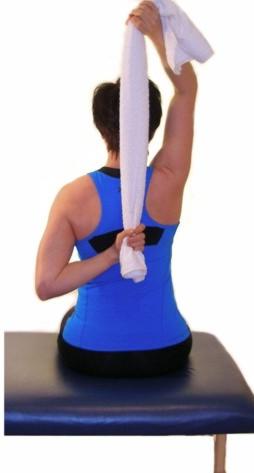
Exercises for Seniors: Doorway Stretch
This stretch stretches the muscles on the front of your chest and
shoulders.
- Only lift your arms into the doorway as far as you comfortably can. If you have shoulder pain, consult your physical therapist prior to performing this stretch.
- Keep your chest up and take a small step into the doorway. Only move into the point of resistance.
- Hold this position for 30 to 60 seconds.
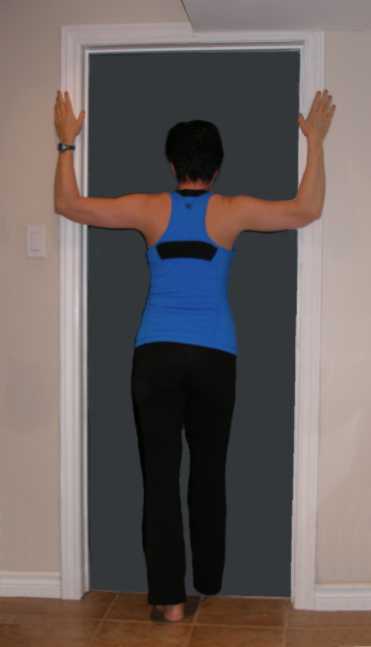
Exercises for Seniors: Neck Flexion
With prolonged sitting at computers we become accustomed to the forward
head posture. This posture leads to tightness in the short neck
extensors and can further narrow disc spaces in the neck leading to
aggravation of arthritis and pinched nerves. This stretch works to
stretch these tight extensors and open up the spaces where the nerves
come out of your neck.
You must be sure to keep your chin tucked in prior
to pulling your head forward to minimized shearing forces on the
vertebrae in your neck. Shearing forces can further aggravate arthritis
and pinch nerves. If you have a neck condition, definitely consult your
physical therapist prior to doing this exercise.
- Stand or sit tall with your chest up.
- Put one hand on your chin and translate your head back over your shoulders (don't look down or up, you should be looking straight ahead) so you have a double chin.
- Hold your chin back as your reach over your head and gently pull the top of your head forward. This is not a large movement, but is very effective. Remember to be gentle as there are a lot of little joints in your neck and muscles at the base of your skull that may be sensitive.
- Hold this for 30 to 60 seconds.

Exercises for Seniors: Hip Flexor Stretch
The hip flexors will quickly become tight if you spend a lot of time
sitting. Tight hip flexors can often be an indirect cause of back pain
when walking. In order to perform this stretch you may need to put a
cushion or two on the floor for your knee if you have knee stiffness.
- Get down onto the right knee and put your left foot in front of you flat on the floor. It may help to do this next to a chair or bed to hold onto.
- Put your right hand on your right hip, keep your chest up and push your right hip forward. Don't lean forward - keep your chest up.
- At the fully stretched position your right knee should be behind you. Hold this position for 30 to 60 seconds.
- Don't bounce. More benefit is achieved if you don't bounce.
Repeat this on the left side.
If you have arthritic knees, a knee replacement or a hip replacement,
definitely consult your physical therapist prior to attempting this
maneuver.

Exercises for Seniors: Hamstring Stretch
The easiest way of stretching the hamstrings without straining your
back is to perform the standing hamstring stretch.
- Find a stool or chair and put your right foot up on the chair.
- Straighten your right knee, keep your chest up and your back straight as you slowly lean forward toward your right foot.
- You can gently hold your right knee straight as you do so to prevent it from bending up.
- Hold this position for 30 to 60 seconds.
Definitely don't bounce into this as bouncing can
cause muscle or back injury. You gain more by holding a sustained
stretch.
Repeat this with the left leg.

Exercises for Seniors: Calf Stretch
- Stand back from a wall and place both hands on the wall so that your arms are straight.
- Place your right foot behind you while keeping your toes pointing forward.
- Keep your right heel on the ground and your right knee straight.
- Slowly lean forward until you feel a stretch in the back of your leg.
- Hold this for 30 to 60 seconds. Don't bounce, as a sustained stretch is more effective and bouncing can lead to injury.
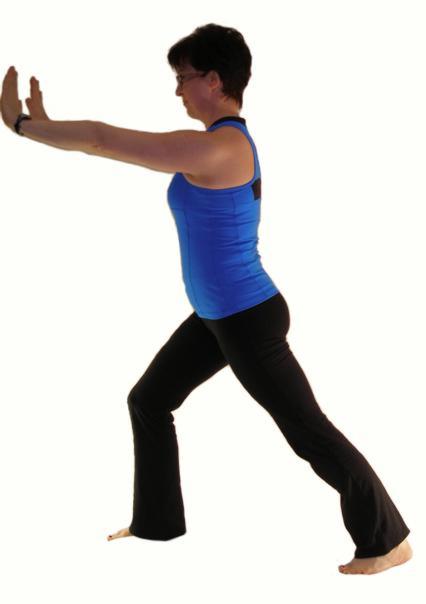
- From this position bend the right knee, and while keeping your heel on the ground, hold this position for an additional 30 to 60 seconds to stretch both parts of the calf musculature.
- Repeat on the left side.
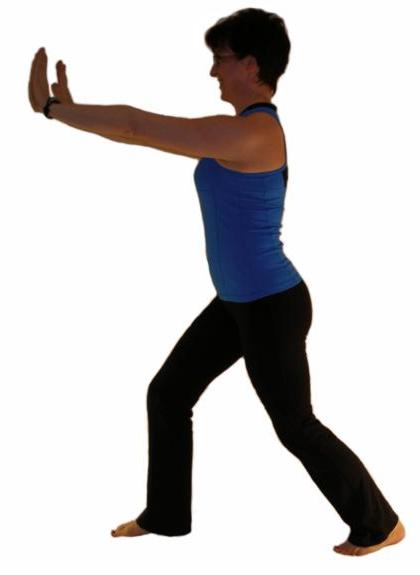
Barriers to Stretching and Exercise in the Elderly
You don't have to be over 65 to have a lack of motivation for exercising.
People may be reluctant to start an exercise program for any of the following reasons:
- Fear of injury or pain
- A belief of "no pain, no gain"
- Lack of knowledge of the beneficial effects of exercise
- Not knowing where to start of which exercises to perform
- A thought that "damage is done, it's too late to start now"
Start by getting clearance from your family doctor, get active
gradually, and seek the advice of a professional if you're not sure of
mechanics of an exercise, how you should progress, or which exercises
are best for you.
Related Sites
Exercise
& Physical Activity for Older Adults
(National
Institute on Aging)
Exercise
& Physical Activity: Your Everyday Guide
(National
Institute on
Aging)
Aging
and Seniors - Public Health Agency of Canada (Government
of Canada)
Physical Activity Guidelines for Older Adults (British
Government NHS)